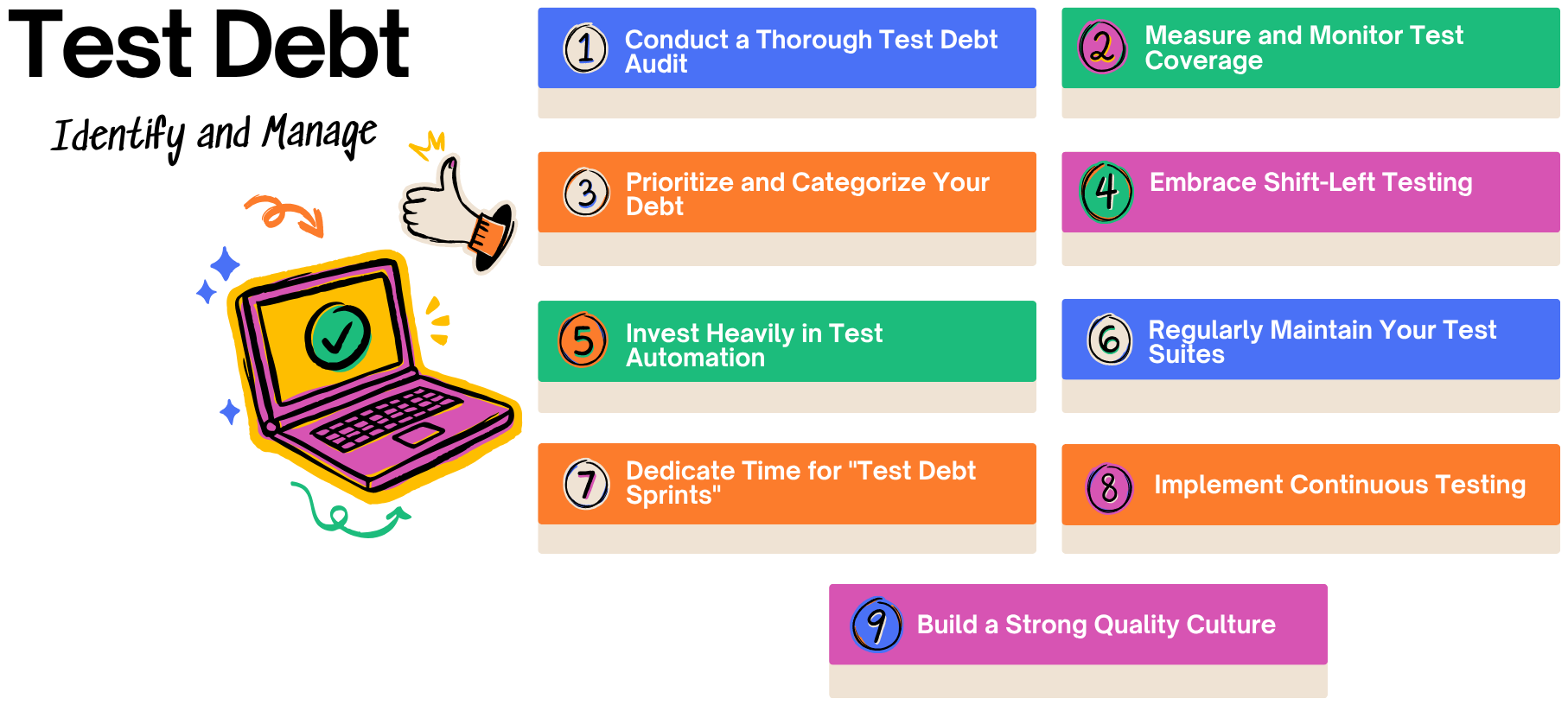What is Test Debt?
|
|
Ever settled for “we’ll fix that later” after a push under tight deadlines? You know, where you slack off on writing those successive tests, or maybe you don’t quite manage to refactor those old test-cases in the end?
We’ve all been there. It’s also easy to make those small compromises in the heat of the moment, thinking they won’t hurt much. But just as a pin-hole in a dam is the beginning of the end, those little testing shortcuts can add up, creating what we refer to as test debt.
Why should you care? Because this relatively innocuous backlog of missed tests and quality issues can cause hundreds of thousands of dollars in lost productivity, stall future development, and just end up costing you a lot more in the long run.
| Key Takeaways: |
|---|
|

What is Test Debt?
Test debt at its most basic is the sum of missing, incomplete, or low-quality testing work done over the lifetime of a software project. It is a choice that is often made consciously, which time pressures or resource limitations may help justify – to send software into the field with insufficient quality assurance. Though it can also build up accidentally, due to rotting old test suites, or just not having enough tests around new features.
It’s a close relative of technical debt, but with a focus on your testing efforts — or rather, your lack of them. Where technical debt is more about not-so-great code or architectural decisions, software testing debt is the result of not enough test coverage, test rot, or just not taking care of your quality assurance in general.
The key characteristics of test debt are quite telling:
- It’s often a decision, conscious or not: Sometimes, you know you’re cutting corners on testing. Other times, it’s a gradual erosion of quality as tests become outdated or simply aren’t written for new code.
- It accrues interest: Just like financial debt, test debt doesn’t sit idle. The longer it goes unaddressed, the more “interest” it accumulates in the form of more complex bugs, harder-to-fix issues, and a general slowdown in development.
- It’s not always visible at first: You might release a product with significant test debt and not see immediate consequences. The problems usually surface later, often in production, when they’re far more expensive and embarrassing to fix.
How Does Test Debt Accumulate?
Here are some of the most typical examples of how this software testing debt builds up:
- The “We’re in a Hurry!” Trap – Tight Deadlines and Rush Releases: This is one of the most common. When deadlines are tight and resources are tight, corners tend to get cut. Testing cycles may be shortened, “non-critical” testing skipped, or quality assurance rushed. The inevitable focus on shipping the thing now means your long-run commitment to quality is directly behind when it comes to prioritization, or worse, forgotten.
- The Manual Grind – No Test Automation: As anyone who does a lot of manual testing knows all too well, manual testing is a contributor to test automation debt. As your software becomes larger, re-running hundreds or thousands of tests manually just doesn’t scale. Regression tests are a must, but teams either take ages to implement them or just skip them, and end up with a version of the app without essential regression. The non-automated tests just add to the pile of debt.
- Blind Spots – Bad Test Coverage: Are you absolutely sure which features of your application have solid test coverage? If not, you probably have test debt due to poor coverage, which is to say that key functionality, edge cases, or sometimes whole units of code get woefully under-tested. When changes are implemented in these untested parts of your application, you’re effectively flying blind, which means that the chances of causing defects to make their way into production are higher.
- The Ghost in the Machine – Obsolete and Un-maintainable Test Suites: Software is a moving target. If your test cases aren’t updated with the updates in the codebase or new requirements, they become outdated quickly. You could have thousands of “passing” tests that don’t actually test anything relevant, and it might give you a false sense of security. These are zombie tests – they are there, but they’re not really alive or effective, and they are increasing your QA debt.
- Resource Shortages – Lack of Testing Resources: At the end of the day, sometimes it comes down to not having enough QA engineers or a proper testing toolkit. A short-staffed, or low-tech QA team will not be able to keep up with the development schedule and so be forced to test less thoroughly and the backlog of things to test will grow.
- The “Known Issue” Syndrome – Ignoring Test Failures: We’ve all seen it. A test fails, but it’s deemed a “known issue” or a low priority, so the underlying problem isn’t fixed, and the test isn’t addressed. Each ignored failure or “workaround” becomes a piece of test debt, a potential landmine waiting to explode, especially as new features interact with old, unresolved issues.
- “Only New Stuff” – Neglecting Regression Testing: When a new feature is added, are you also ensuring that existing functionalities haven’t been broken? If your team isn’t consistently running a robust suite of regression tests, old bugs can resurface or new bugs can be introduced into previously stable areas. This creates regression debt, forcing your team to fight battles they thought they’d already won.
- The “It Works, Doesn’t It?” Mentality – Skipping Non-Functional Testing: Performance, security, usability, these often get deprioritized in the rush to release. If your application isn’t tested for how it performs under load, how secure it is against vulnerabilities, or how easy it is for users to navigate, you’re accumulating significant test debt that could lead to major outages, data breaches, or a terrible user experience down the line.
The Impact of Test Debt
Ignoring test debt might seem like a quick win in the short term. But like any debt, it comes with interest, and the longer you let it fester, the more expensive and damaging it becomes. Here’s why you simply can’t afford to let test debt pile up:
- Increased Bugs in Production: This is the most direct and painful consequence. When you don’t have adequate tests, defects inevitably slip through the cracks. These hidden bugs then surface when your customers are using the software, leading to a frantic scramble to fix issues under pressure. Imagine users encountering critical errors or data loss – it’s a direct result of that skipped testing.
- Slower Release Cycles and Development Grind: Counter-intuitively, cutting corners on testing actually slows down your development in the long run. If you have significant QA debt, every new feature or bug fix becomes a gamble. Teams spend more time manually re-testing old functionalities, debugging issues that should have been caught earlier, and dealing with unexpected regressions. This constant firefighting means less time for innovation and slower delivery of new value.
- Higher Development Costs: The famous adage holds true: fixing a bug in production is exponentially more expensive than catching it during development. Each minute spent on emergency bug fixes, customer support for reported issues, and hot patching adds significant unplanned costs. Managing test debt proactively can save your budget from these unexpected drains. Read: Minimizing Risks: The Impact of Late Bug Detection.
- Reduced Team Morale and Burnout: No developer or QA engineer enjoys constantly putting out fires or fixing the same old bugs. A high level of test debt leads to a perpetually stressful environment where teams are reactive rather than proactive. This can lead to frustration, demotivation, and even burnout, impacting overall productivity and retention.
- Damaged Reputation and User Dissatisfaction: Today, users expect flawless software. Frequent bugs, crashes, or poor performance due to software quality issues will quickly erode user trust and drive them to competitors. A damaged reputation is incredibly hard to repair and can have long-lasting effects on your brand.
- Loss of Business Opportunities: When a significant portion of your development resources is tied up in fixing old problems caused by test debt, your ability to innovate or respond quickly to market changes diminishes. This means missing out on new features, product improvements, or even entire market segments because your team is stuck in a cycle of maintenance.
- Security Vulnerabilities: Untested areas aren’t just prone to functional bugs; they can also harbor serious security vulnerabilities. If security testing is part of your testing backlog, you could be leaving your application open to attacks, data breaches, and compliance failures, which carry enormous financial and reputational risks.
Strategies to Identify and Manage Test Debt
By implementing the right strategies, you can significantly reduce your existing debt and prevent new debt from accumulating. Here’s how to identify and effectively manage your software testing debt:

- Conduct a Thorough Test Debt Audit: You can’t fix what you don’t acknowledge. Start by performing a comprehensive assessment of your current testing practices. Look at your test coverage reports (if you have them), analyze bug trends, and interview your development and QA teams. Ask critical questions: Where are bugs most frequently found? Which areas of the application are rarely tested? How often do tests break, and are they fixed promptly? This audit will highlight your biggest areas of QA debt.
- Measure and Monitor Test Coverage: Tools are your friend here. Use code coverage tools to pinpoint exactly which lines of code are (or aren’t) being exercised by your tests. Beyond just lines of code, consider feature coverage – are all critical user flows and business requirements being tested? Regularly monitoring these metrics will give you a quantifiable understanding of your testing backlog and where to focus your efforts.
- Prioritize and Categorize Your Debt: Just like with financial debt, you can’t pay it all off at once. Prioritize your test debt based on its impact and risk. Which areas, if they fail, would cause the most severe consequences (e.g., critical business functions, security vulnerabilities, high-traffic features)? Categorize your debt (e.g., missing unit tests, outdated integration tests, lack of performance tests) to help you strategize your approach.
- Embrace Shift-Left Testing: One of the most powerful strategies for reducing test debt is to “shift left” – meaning, integrate testing activities earlier into the development lifecycle. Instead of testing only at the end, involve QA from the requirements gathering phase, encourage developers to write unit tests for their code, and perform early integration testing. Catching defects early dramatically reduces the cost and effort of fixing them later.
- Invest Heavily in Test Automation: This is non-negotiable for managing test debt in modern development. Automate repetitive, stable, and high-priority tests across all layers (unit, integration, end-to-end, API). Automated tests run quickly, consistently, and free up your manual testers to focus on exploratory testing and more complex scenarios. If you’re constantly repeating manual test steps, you’re building test automation debt. Tools like our platform are designed to help you create, manage, and execute these automated tests efficiently, ensuring consistent coverage without the manual overhead.
- Regularly Maintain Your Test Suites: Tests aren’t a “set it and forget it” affair. Treat your test suite like production code. Regularly review, refactor, and update tests as your application evolves. Remove obsolete tests, fix flaky ones, and ensure they accurately reflect the current system behavior. Neglecting this maintenance is a fast track to accumulating more test debt.
- Dedicate Time for “Test Debt Sprints”: Sometimes, you need a focused effort to tackle a significant chunk of accumulated debt. Schedule dedicated “test debt sprints” or allocate a percentage of each sprint to address the testing backlog. This ensures that paying down debt isn’t just an afterthought but a planned activity within your development cycles.
- Implement Continuous Testing: Integrate your automated tests into your Continuous Integration/Continuous Delivery (CI/CD) pipeline. This means tests run automatically every time code is committed or a build is created. Continuous testing provides immediate feedback, allowing developers to catch and fix issues almost instantly, preventing debt from accumulating from the get-go.
- Build a Strong Quality Culture: Ultimately, reducing test debt is a team effort. Encourage everyone, from product managers to developers to QA, to take ownership of quality. Promote practices like test-driven development (TDD) where appropriate, encourage peer code reviews that include test reviews, and celebrate successes in improving quality.
Intelligent Test Automation to Counter Test Debt
By now, you’re likely nodding along, recognizing some of these test debt scenarios in your own work. You understand the pain points, the hidden costs, and the frustration of constant firefighting. The good news is that you don’t have to tackle this mountain of debt alone. This is where a powerful automated testing platform like testRigor comes into play.
This Gen AI-powered test automation tool is specifically designed to address the very challenges that lead to software testing debt, helping your team pay it down and build a more robust, reliable software delivery pipeline. But how does it stand out from the crowded field of test automation tools? It’s not just about automating tests; it’s about making that automation sustainable and accessible, which is key to truly reducing test debt.
Here’s how testRigor becomes an essential ally in your fight against test debt, often outperforming traditional and even other “codeless” solutions:
- Effortless Test Creation and Maintenance: A major source of test automation debt is the sheer difficulty in creating and, more critically, maintaining automated tests. Traditional tools often rely on brittle selectors (like XPaths or CSS locators) that break with minor UI changes. testRigor revolutionizes this. It allows you to write tests in plain English, just like you’d describe a manual test case. This means:
- Anyone can write tests: Manual QAs, business analysts, and even product managers can contribute to automation. This dramatically expands your testing capacity without needing to hire an army of highly specialized automation engineers, directly tackling the testing backlog.
- Ultra-stable tests: testRigor doesn’t rely on flaky technical locators. Instead, it “sees” elements on the page the way a human user does, recognizing them by their visual appearance, label, or position. This significantly reduces test fragility, meaning your tests don’t break with every minor UI tweak. We’re talking up to 99.5% less maintenance time compared to Selenium-based solutions! This near-zero maintenance is a game-changer for reducing test debt.
- Comprehensive Test Coverage with Generative AI: You can’t fix what you can’t see, and you can’t test what you haven’t thought of. testRigor goes beyond basic coverage reports. Its generative AI can actually generate entire automated tests based on simple, plain English descriptions. This means:
- Rapidly expand coverage: Get comprehensive test suites built much faster, closing those crucial coverage gaps that contribute to QA debt.
- Behavior-driven testing: Tests are created from a user’s perspective, ensuring that what’s being tested truly reflects real-world scenarios, making your testing efforts more valuable.
- Seamless CI/CD Integration for True Continuous Testing: The fastest way to accumulate test debt is by not testing frequently enough. testRigor integrates smoothly with popular CI/CD tools, enabling true continuous testing. Automated test runs are triggered automatically with every code commit or build. Unlike tools that require complex setup for parallel execution, testRigor runs tests in parallel by default, providing immediate feedback to developers and catching bugs early, before they have a chance to become ingrained test debt.
- End-to-End Testing Across All Platforms: Many tools are limited to web or mobile. testRigor provides true end-to-end testing across web, native mobile, native desktop, mainframe applications, APIs, emails, and even SMS messages, all within the same test. This comprehensive coverage means you don’t accrue debt by having gaps in your cross-channel testing.
By using testRigor, teams can accelerate their release cycles, significantly enhance software quality with ultra-stable tests, drastically reduce unforeseen costs tied to test maintenance, and empower their entire team, not just coders, to contribute to quality.
Conclusion
While test debt is undeniably a prevalent concern in the software industry, it’s not a force with which to be reckoned. By knowing how it’s incurred and proactively mitigating it by way of strong automation, continuous testing, and thinking quality-first, you can begin chipping away at your technical debt and lowering its interest rate over time. It’s not just about efficiency, though; investing in tools that make your testing seamless (like testRigor) is an investment in a sustainable, high-quality development process.
| Achieve More Than 90% Test Automation | |
| Step by Step Walkthroughs and Help | |
| 14 Day Free Trial, Cancel Anytime |












